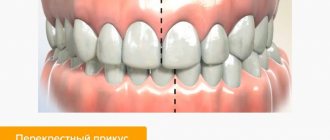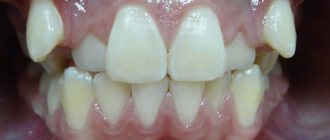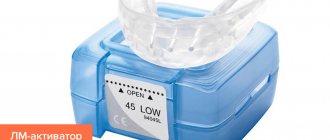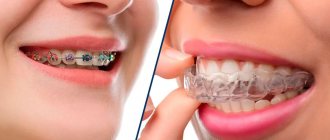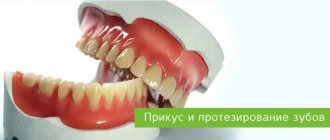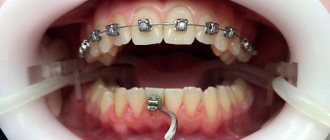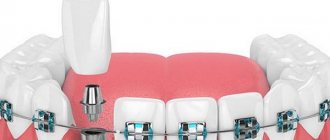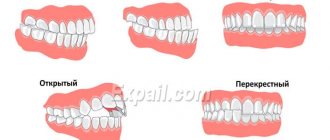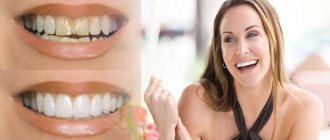Having managed to grow up, many never met an orthodontist, although they visit other specialists in dental clinics.
It may surprise you, but of all the dental specialties, orthodontics is primarily responsible for the condition of teeth and gums, a harmonious face and a beautiful smile, as well as for the general health and psychological comfort of a person.
What’s even more interesting is that very often, orthodontic treatment allows you to achieve all of the above without pain and surgical intervention, only through the use of “small forces” , which we will talk about in this article.
The term ORTHODONTICS comes from the Greek words orthos - straight , correct and odus, odontos - tooth and was first used in 1840, but the treatment of defects in the dental system began much earlier.
Initially, the task of ORTHODONTICS was to correct the incorrect position of individual teeth. As a rule, the anterior teeth of the upper jaw were treated solely for aesthetic reasons. Treatment could be reduced to pressing with a finger on a crooked growing tooth, removing or rotating the teeth with forceps.
As it develops, orthodontics has become a medical discipline that studies the causes of dental anomalies, their impact on the human body and the creation of effective methods of prevention and treatment.
The demand for orthodontic treatment is constantly growing and today braces are a sign of wealth, a demonstration of concern for one’s health and beauty.
Let's figure out why it is necessary to correct defects in the dental system and get acquainted with the methods of orthodontic treatment.
Types of occlusion defects and methods of their correction
Scientists have calculated that only 40% of the planet's inhabitants are the happy owners of an ideal bite. All others have deviations from the norm to one degree or another. Defects can be critical when they have a negative impact on human health, and practically unnoticeable, not leading to moral or physical discomfort.
The picture below shows occlusion anomalies:
Modern orthodontics includes several methods for correcting malocclusion:
- using braces;
- through surgery;
- using myotherapy (physical exercises) and non-braces corrective devices.
Dental aesthetics in case of malocclusion
Is it worth getting your teeth done just for the sake of a smile and beauty?
It's impossible to separate here. Nature has honed man, the human body, his organism for hundreds of thousands of years. Function dictates form. In the process of human evolution, the correct form is perceived as beautiful. A healthy, strong body looks beautiful, you must agree. The same with teeth: if the teeth look beautiful, they are proportional, they are in the right position. This means that they function correctly, that is, function determines aesthetics. These are inseparable concepts and today dentists understand this.
In fact, as soon as a person acquires beautiful teeth, he immediately begins to smile more often, his life changes dramatically, because he is positive and he begins to attract the same people. For many people, their lives change after orthodontic treatment. Girls come and after orthodontic treatment are transformed - they get married and give birth. And they become smiling.
Modern methods of bite correction
You need to understand that orthodontic treatment takes quite a long time and, for example, for many people, braces are like a STOP sign. The question often arises: is it possible to correct a bite without braces?
What methods of bite correction are there for adults? Although this is also very important for teenagers.
If we talk about methods of treating incorrect position of teeth, then transparent aligners have recently appeared. But in America, for example, it is now fashionable to wear braces, and metal ones so that they can be seen - this tells others that a person is monitoring his health.
Today there are two main directions
in orthodontics.
1. These are classic braces
with arches that change throughout the treatment period.
Let's digress a little from braces and talk about them exactly the other way around - are there any patients who say we don’t want braces, let’s just get veneers and that’s it?
We are now talking about the situation of how to correct an overbite without braces. Yes, of course such patients do exist. You have to talk with them for a long time and still convince them that the orthopedist works with fixed teeth. What does an orthopedist do? He can glue veneers, he can treat the tooth for a crown (correct the bite with crowns), etc., but he cannot move the tooth - this is not his profile. Therefore, at the first stage of aesthetic dental treatment, an orthodontist can be involved. In some cases, veneers cope well with problems on their own; by the way, our team has accumulated many years of experience in installing veneers. Below, in the photo, one such situation is presented when the patient did without treatment with braces:
If we want to correct the incorrect position of teeth with the help of veneers or crowns, then we must grind off part of the tooth tissue. We try to convey to the patient that if there is a small orthodontic correction - we move the teeth into the correct position, then we will then install the veneers very delicately, that is, we will not grind off excess tissue. A person, of course, does not want to lose what he has, so he naturally agrees, the main thing is to explain, to convey it. The most important thing is not to do harm and to correctly explain to the patient what result we want to achieve, what will happen at the end of this treatment
2. These are transparent aligners - aligners
.
The principle here is this: a person’s jaw with teeth is scanned, loaded into a special program, the doctor-operator who works in this program carries out the virtual movement of the teeth step by step and a model and a mouthguard are made for each step. And what’s most important is that we can see the results of treatment even before it even begins. This treatment is calculated depending on the case from 10 to 30 or more mouth guards, but unfortunately there are also disadvantages to this method, he will say, some serious movements of the teeth, correction of such rather complex cases is impossible with mouth guards, although certain progress is now taking place in this method, this direction is developing, but so far it is not a panacea, that is, it does not apply to all cases.
About the specifics of treatment with braces
Do braces correct an overbite? Definitely yes! Most orthodontists work with straight arches, but not so long ago the multi-loop arch technique appeared, developed by the Japanese professor Sadao Sato: when he moved to Europe, he met the gnathologist Rudolf Slavichek. And in this union they came up with a concept. There are not many doctors in Russia who know such equipment.
What is the meaning of the multi-loop arc technique? A person who owns this technique, firstly, takes into account the position of the lower jaw, the position in the joint, and the multi-loop arch technique allows you to move each tooth individually in three planes, that is, when using it, treatment takes exactly six months less. And, as a rule, there are no relapses.
Often, orthodontists recommend wearing retainers for life after orthodontic treatment, wearing night guards for about a year, etc. If the tooth has taken its correct position, and the correct position of the tooth is the only one in the jaw, and the lower jaw in relation to the upper jaw also occupies the correct position, then there will be no relapse. With the help of the multi-loop arch technique, this is, in general, really possible to achieve, but here, of course, the orthodontist must have fairly in-depth knowledge.
Treatment with braces has its own main feature - they are developed by orthodontists themselves. Often, treatment with a braces system is based on the concept of one of its authors, with his logic of tooth movement in a particular malocclusion pathology. For example, the now popular Pitts 21 braces and its varieties. And in order to effectively treat a bite with such a brace system, you must have serious orthodontic experience and good medical practice.
In general, braces and braces are different - there are ceramic braces and lingual ones, but in any case, braces are one of the most reliable and working systems.
The multi-loop arch technique also involves treatment with classic braces, it’s just that the arch itself is different; the doctor makes it by hand individually for each tooth and creates its own curves.
There is another technique that has also gained popularity - the mini screw technique. A mini screw is installed in the jaw and a lock is glued to the tooth, traction is created and the tooth moves with the help of these mini screws, it is also very effective, you can work with teeth very quickly, but this is usually in adult patients, when teeth are missing and it is necessary to correct These defects occur in the long-term absence of 1-2 teeth.
How often does the question of braces or aligners come up?
What do you choose more - braces or aligners? About 5 years ago, aligners were not so affordable. But now there are a large number of manufacturers in different price categories. Among them, one can single out the undisputed leader - Invisalign, the quality of which has so far been unsuccessful, but numerous of its “analogs” are trying to approach.
How well do aligners correct a bite? Of course, the effectiveness of aligner malocclusion depends on the complexity of the case, and there are degrees of complexity within the aligner system itself (this is called case size). There is an opinion that with the help of aligners you can not correct, but correct the bite, so specialists already at the consultation determine which system to use for treatment. Therefore, I repeat once again, you need to come to doctors, you need to consult, you need to get a competent opinion, and each doctor in a particular situation chooses the system that will most effectively help the patient correct his bite. Thus, we again return to the qualifications and experience of the orthodontist, whom you trust to make your teeth straight and beautiful.
How do children feel about aligners, and how ready are they to have them installed?
I am currently treating a young patient, he is 14 years old. At the moment, preparations are underway for orthodontic treatment. He always says to both parents and doctors: “This is so cool, I’ll soon get aligners, great!” Nowadays they make such cool aligner systems that they are not just functional, they are very beautiful! Therefore, young patients have become more likely to agree to treatment with aligners. Young people have fewer and fewer complexes about correcting their bite. And this is great!
At what age should you start correcting your bite?
Dentists believe that occlusion correction can be carried out at any age using appropriate techniques. Thus, children are not treated with braces because their skeletal system is in active growth, and the bones, including the dentofacial apparatus, have not yet formed. Therefore, young children, before they have permanent teeth yet, are treated with myotherapy, plates and trainers. Note: such methods are used in the presence of non-critical developmental defects. Complex congenital pathologies that have a negative impact on the health or quality of life of the baby are treated surgically.
The optimal period of treatment with braces is from approximately 12 to 16 years. At older ages, the process takes longer.
Important: some dental anomalies can be corrected without the use of braces. The possibility of such treatment is determined by the doctor.
Is it possible to correct an adult’s bite on their own?
In childhood, even before the eruption of permanent teeth, you can set the right direction for the development of your bite on your own. For this purpose, the child is relieved of bad habits and is also forced to wear special trainers that reduce pressure on the teeth.
In adulthood, the situation, unfortunately, is more complicated. The bite has already fully formed, and all that can be done is to go to the orthodontist so that he can prescribe and install devices for its correction.
Mouth guards for bite correction
Sometimes on the Internet you can find supposedly universal mouth guards for sale that “help” correct the bite in adults. But all anomalies are individual, and in order to correct a defect in a particular person, you need to make a device individually for his bite. Therefore, all “universal” devices are not suitable, and there is no way to correct the bite at home - you must definitely go to an orthodontist.
Corrective exercises – myotherapy
As a rule, myotherapy is an addition to the correction of occlusion using various orthodontic devices or as the main method in the treatment of children from 4 to 8 years old. Physical exercises help develop and strengthen facial muscles, stimulate bone growth, and have a positive effect on trophic processes.
Let's look at some effective exercises:
- to correct a deep bite: stand straight with your chin raised as much as possible. Move the lower jaw forward, then return to its original position. Repeat 15 – 17 times;
- to correct open occlusion: take a pencil (you can put a rubber tube on it), squeeze it with your teeth with adequate force. Perform for 4 – 5 minutes;
- with a crossbite: open your mouth as wide as possible, move your jaw towards the defect, close your jaws in the correct position for 5 seconds, then relax, then repeat the exercise again;
- to correct mesial occlusion: use your tongue to press on the inside of the front part of the upper dentition. Perform the exercise for 5 minutes.
Important: when performing any exercises of the myogymnastics complex there should be no pain. After each approach, you need to let the muscles relax for 1 minute.
Correction of adult occlusion with removable aligners
Braces are not convenient for everyone - they still interfere with proper dental care and in most cases are noticeable to others. Therefore, there is another way to correct bite in adults - transparent removable aligners.
Such mouthguards are made individually, according to the patient’s jaw model. They are made of transparent plastic, which is designed in such a way that it puts pressure on the teeth in much the same way as the arch of braces does. The aligners are changed during the treatment to more and more rigid ones, and in the end the teeth are in the correct position.
Advantages
- Inconspicuous compared to many other types of braces.
- Possibility to remove while brushing teeth and eating.
- Easy care.
- They do not cause pain and do not scratch gums and cheeks.
- Suitable for people with metal allergies.
Flaws
The cap has one significant drawback. Plastic cannot act as strongly as metal, so aligners unfortunately cannot cope with serious abnormalities such as crowding or crossbite. They are also not suitable for changing the position of the jaws relative to each other, since the aligners of the upper and lower jaws are not connected to each other.
Another disadvantage is that mouth guards are only suitable for disciplined people. If you forget to put them on a couple of times, the treatment will have to start almost from scratch.
The last disadvantage is that the cost of the mouth guards is comparable to the most expensive types of braces. Considering that they only correct minor bite defects, such an expense may seem unjustified.
Records
Vestibular plates are removable orthodontic devices. This means that they can be removed for a while, for example, to eat or brush your teeth. The plate for correcting pathologies is made individually for each patient using personal casts of the jaws.
The base of the plate is a plastic base that is adjacent to the palate. Arcs, clasps and screws are integrated into it. The base color can be neutral or colored.
These devices are mainly used in childhood and adolescence, when the dental system is not yet fully formed and therefore the dental elements are able to move relatively easily under the influence of directed force. The plates are also used to correct pathologies in adult patients, but only in mild cases.
How to prevent malocclusion in adulthood
If you are lucky and by the age of 18–20 you have a completely normal bite, this can be maintained until old age. To do this, you need to follow the following recommendations:
- Visit the dentist every six months to a year. He recognizes malocclusion at an early stage, and also notices in time any diseases that can lead to tooth loss and malocclusion.
- Treat any diseases of the teeth and gums in a timely manner. Untreated caries or gingivitis can ultimately easily lead to tooth loss, and therefore to malocclusion.
- Find out in advance about the condition of your wisdom teeth. If the eights have not yet erupted, you should go to the doctor and get an x-ray to see if they are growing sideways or putting pressure on neighboring teeth. It may be better to remove these teeth. If they begin to erupt, you should also consult a dentist to understand whether eruption is proceeding normally.
- Avoid jaw injuries. Protect your face while playing dangerous and contact sports.
- Eat solid foods more often: vegetables and fruits. This keeps teeth in “working” condition and helps keep them healthy longer.
- Do not bite hard objects with your teeth or open bottles. Because of this, teeth can easily break off and become destroyed.
- If a tooth is lost, a prosthesis should be installed immediately to prevent other teeth from moving into the resulting space.
Trainers
Orthodontic trainers are removable silicone covers for the teeth. They are worn for several hours a day: at night and for 2–4 hours during the day. They are used to correct occlusion in children and in simple situations (for example, when there are gaps between dental elements) in adults.
There are several types of trainers:
- standard for the initial stage of treatment - made of soft pink silicone. This period lasts about six months. The main goal is to influence the position of the jaws and facial muscles;
- standard for the final stage - made from harder blue silicone. They directly influence the movement of teeth in the dental row;
- Lm-activators are trainers, the unique feature of which is that they can be used before all teeth erupt, when the process is just beginning. Their use allows the teeth to settle into place immediately after eruption;
- myobraises – allow for early correction in a natural way, from the age of 3 years. The system does not work on the consequence, but on the causes of the formation of malocclusion. Myobraises are worn for 1 hour during the day and worn throughout the night.
Causes of malocclusion
How and why does malocclusion appear? And are there any ways to protect a child’s teeth at a very early stage of development of the dental system?
Let's start explaining what malocclusion is and what its types are.
Malocclusion is a fairly broad topic. It is best to start with bite prevention in children. So,
Prevention of bite in children
From the first days of a child, from infancy, breastfeeding is very important, because today it is recommended to feed a child for 6-9 months, the baby tries, sucks at the breast, his muscles work - his jaws develop. That is, with insufficient muscle activity, underdevelopment of the jaw bones occurs, which subsequently leads to more difficult to correct situations at later stages of the child’s development.
Because if a child’s jaw is underdeveloped - the teeth have grown and there is not enough space for them, then you need to think about what to do, so prevention and observation must begin from infancy. There are, of course, situations when the mother does not have milk, in which case it is better to choose bottles and nipples that are difficult to suck, so that the milk itself does not flow.
At what age should a child begin seeing an orthodontist?
It would be correct to show a child who is one year old to a doctor, if he does not have any anomalies - to an orthodontist. And the orthodontist will say that we wait until the child has all his teeth, and then we will take or not take any action.
Of course, if a child has caries, then we take every action to alleviate this situation, even going so far as to show mothers how to brush their teeth correctly, and children take an active part in this.
Our team of specialists includes doctors who see children. Now this age is from 6 years
.
Mouth guards
Mouthguards, or aligners, are removable plastic or silicone transparent covers on the teeth. Made individually for a specific patient. They are worn constantly and are removed only for eating and hygiene procedures.
They are practically invisible, so they do not cause moral discomfort. The therapeutic effect is determined by a soft force effect on the dental elements, causing them to move in a given direction. The main disadvantage is the inability to eliminate particularly complex defects.
Important: the effectiveness of mouth guards for correcting malocclusion depends not only on the severity of the clinical case, but also on strict self-discipline. Failure to comply with the orthodontist's instructions will negate all efforts made.
Bite correction with adult veneers
Sometimes bite defects in adults are very minor and purely cosmetic - for example, there are gaps between the front teeth, or some teeth are slightly shorter or longer than others. Such defects in the smile area are not dangerous to health, but seriously spoil aesthetics.
To eliminate them, it is not necessary to carry out full-fledged long-term orthodontic treatment. Defects can be masked with veneers - ceramic plates that are installed on the teeth and completely cover them. Veneers can be made slightly wider or longer than natural teeth, and thus cover all defects.
In addition, if you put veneers on all your front teeth, you can create the effect of a snow-white Hollywood smile - they will mask all the darkening and enamel defects, making your teeth perfect in every sense.
Artistic restoration of teeth
If there is no time or opportunity to fix a defect, it can be disguised. It is not advisable to put on braces or spend money on a set of aligners for the sake of 1-2 crooked teeth. You can change the appearance of dental crowns using composite materials. In this way, you can remove scars and diastemas, visually lengthen your teeth, and correct the cutting edges of your teeth.
Artistic restoration can also be used after treatment with orthodontic structures in order to bring the result to perfection, cover areas of enamel damage when removing locks, and disguise other defects.
As you can see, braces are not the only way to achieve a perfect smile. They are not suitable for everyone and not everyone needs them. To choose the most effective way to eliminate defects in the dentition, you can contact an orthodontist and listen to his opinion.
Reviews about bite correction
Reviews of bite correction for adults confirm that this is not a hopeless matter - almost everyone eventually managed to achieve a perfect smile. Here are typical examples of reviews:
“I got regular metal braces to save money. I had to wear them for two whole years, then I wore the plate for another two years, but I only put it on at night, there were no problems. Now five years have passed since the treatment, my teeth are straight, everything is fine. I won’t say that there were any special problems, but I’m happy with the result.”
“To be honest, the braces themselves were terrible (Well, for me, at least. Brushing my teeth was inconvenient, in the first two weeks everything hurt. Then I got used to it, but my cheeks still sometimes scratched, I had to cover it with wax. And even though they were ceramic, people "They still noticed it around me. But I think it’s worth it - now I’ve taken off my braces and my teeth are perfectly straight! They installed a permanent retainer, but I hardly feel it, no inconvenience. So I think it was worth the patience."
“My teeth were just a little uneven, but it was annoying. I went to the dentist, and in the end they agreed on mouthguards - I can’t afford to wear braces. As a result, the treatment went unnoticed not only for those around me, but even for me - no pain, no discomfort, I can take it off and eat whatever I want, brush my teeth in peace. Remembering how I wore braces for six months as a child and comparing, I understand that in general everything went without problems. Now I wear other mouthguards to secure them, but they are still very comfortable.”
There are practically no negative reviews about bite correction. Yes, patients complain about pain and inconvenience, but in the end they are still satisfied with the result and maintain a beautiful smile for life.
Benefits of aligner treatment
Why are many people afraid of having braces? Mainly because this design creates a lot of inconvenience in everyday life. It is unaesthetic, difficult to care for, imposes significant restrictions on the choice of food products, and causes significant discomfort and pain immediately after installation and after each activation procedure.
All this is irrelevant for patients with aligners. The mouth guards can be removed for cleansing, eating, or attending a significant event. They do not affect diction, which is very important for people who often speak in public. You can take pictures with them, smiling “with all 32 teeth,” communicate, kiss. In general, live a normal life and not feel any restrictions.
In addition, aligners have other strengths:
- the material from which the mouthguards are made does not absorb pigments from food and drinks, and therefore does not darken over time;
- biosilicone is a hypoallergenic material, so it can be used without the risk of complications even in people with polyvalent allergies;
- uniform distribution of pressure over the entire surface of the dental crown provides a softer and more gentle effect on periodontal tissue;
- the absence of discomfort and restrictions contributes to maintaining high motivation and adherence to treatment on the part of the patient until the very end of the correction course;
- the final result of the correction is known in advance, since all stages of treatment are planned using a special computer program.
Safety precautions when performing exercises
When dealing with malocclusion, discomfort may be felt, but it should not be very severe.
After performing this or that exercise, you should let your body relax, move your head in different directions, and take a deep breath. Also, before adding exercises to normalize bites to the correction, you should consult a doctor. Sources:
- Propaedeutic dentistry – Bazikyan E.A.
- Clinical gnathology - Khvatova V.A.
- Orthodontics. Prevention and treatment of functional, morphological and aesthetic disorders in the dentofacial area - Khoroshilkina F.Ya., Persin L.S., Okushko-Kalashnikova V.P.
- Diseases of the temporomandibular joint - Khvatova V.A.
